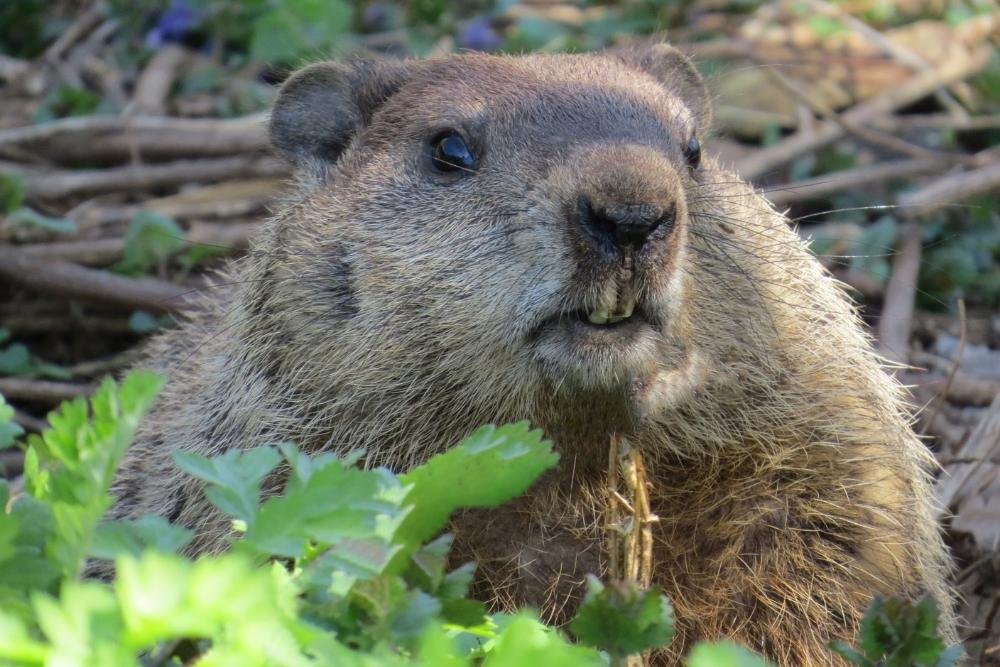Groundhogs
Did you know that the groundhog has three other names? For one, it is known as a woodchuck, although it doesn't chuck wood. However, it does move dirt, and lots of it — up to 700 lbs of dirt and rock in a day with its feet, claws, and teeth! The name woodchuck is derived from a Native American word, wuchak, used to describe several different animals of the same size and color. They are also nicknamed “land beavers,” since they are cousins to the beaver, but they don't live in water. Their most unique name is “whistle pig,” because they whistle to alert others when alarmed.
Who are they?
Groundhogs are the largest member of the squirrel family. They are covered with a dense gray undercoat and a longer coat of banded guard hairs, giving them a frosted appearance. They have short bushy tails, short legs, and big incisors. Their heads are like submarine periscopes with their small ears, eyes, and nose set high on their head so they can poke out of their burrows and scan their surroundings. These diurnal mammals are good climbers and swimmers, and often climb trees to escape predators.
Where are they?
Groundhogs are widely distributed throughout North America and are common in the northeastern and central United States. They can be found as far north as Alaska, and extending southeast to Alabama. They live near woodlands and prefer fields, roadsides, streams, and farms. They are usually seen standing on their back legs eating greens while very close to the roadside. Groundhogs excavate elaborate burrows up to 5 feet deep (below the frost line) and 45 feet long, with one entrance and multiple exit holes for quick escapes. Groundhogs stay within 50 feet of their den. The entrance to the burrow has a built-in flood bump so water will not flow down the main tunnel. The burrows have multiple rooms including a bedroom, bathroom and living area, and are kept neat and orderly.
In addition to using the burrow for regular daily life and rearing young, one time per year the groundhog hibernates in its den. Besides bats, groundhogs are the only true hibernators in our area. The groundhog packs on fat in late summer and when the temperature drops, the groundhog's internal clock goes off, it goes into its burrow and seals itself in a lower chamber called a hibernaculum. Its breathing and heart rate plunge to astonishingly low levels! They take only 1 breath every 6 minutes, have 1 heart beat every 4-5 minutes and the body temp drops to 40 °F. About every two weeks or so, they must wake up to move around a bit and use the bathroom.
The groundhog's internal clock is believed to be affected by changes in sunlight. Hormonal responses are thought to trigger the body to hibernate and then to come out of their hibernaculum near February 2. Groundhog Day is a cross quarter day about halfway between the winter solstice in December and the vernal equinox in March and can be referred to as the midpoint of winter.
What's the scoop on Groundhog Day?
Thousands of years ago, folks in Germany believed the badger had the power to predict the coming of spring. They watched the badger to know when to plant their crops. By the time the first Germans settled in Pennsylvania, they most likely understood this was not true, but the tradition continued. There were no badgers in Pennsylvania, so the groundhog was substituted. Tradition says that if the groundhog sees his shadow on February 2, he will be frightened and return to his burrow for 6 more weeks of winter. If he does not see his shadow, then spring is near.
What's for dinner?
Greens! Dandelion, clover and plantain are favorites. In early spring when greens are not readily available, they may eat bark, buds and twigs of shrubs and fruit trees.
How do they communicate?
In addition to the whistle used as an alarm, teeth grinding and chattering are common when they feel cornered. Groundhogs have also been seen barking and squealing. They may also rub each other's cheeks where their scent glands are located. Groundhogs smell very earthy near their cheeks!
How do woodchucks benefit nature?
While an over-population can damage crops, gardens, and pastures, woodchucks are beneficial in moderate numbers. Their defecation inside the burrow fertilizes the earth; their digging loosens and aerates the soil, and their eating habits can determine which plants will grow. Abandoned burrows can be homes for other animals. Woodchucks can also be an important and abundant food source for large predators like hawks, owls and coyotes.
How do woodchucks benefit humans?
At Cornell University, woodchucks have been studied for 15 years and have led researchers to discoveries in the treatment and prevention of hepatitis B infection and the liver cancer it can cause. Woodchuck hepatitis B virus has a nearly identical effect on woodchuck livers as human hepatitis B virus does on human livers except that time is compressed. Disease processes that take 30-40 years in humans occur in 3-4 years in woodchucks. The only other model for HBV studies is the chimpanzee, an endangered species.
While the groundhog's weather predictions are not always dependable, you can certainly see how important and unique groundhogs are. Think of these wonderful and beneficial creatures this Groundhog Day!


